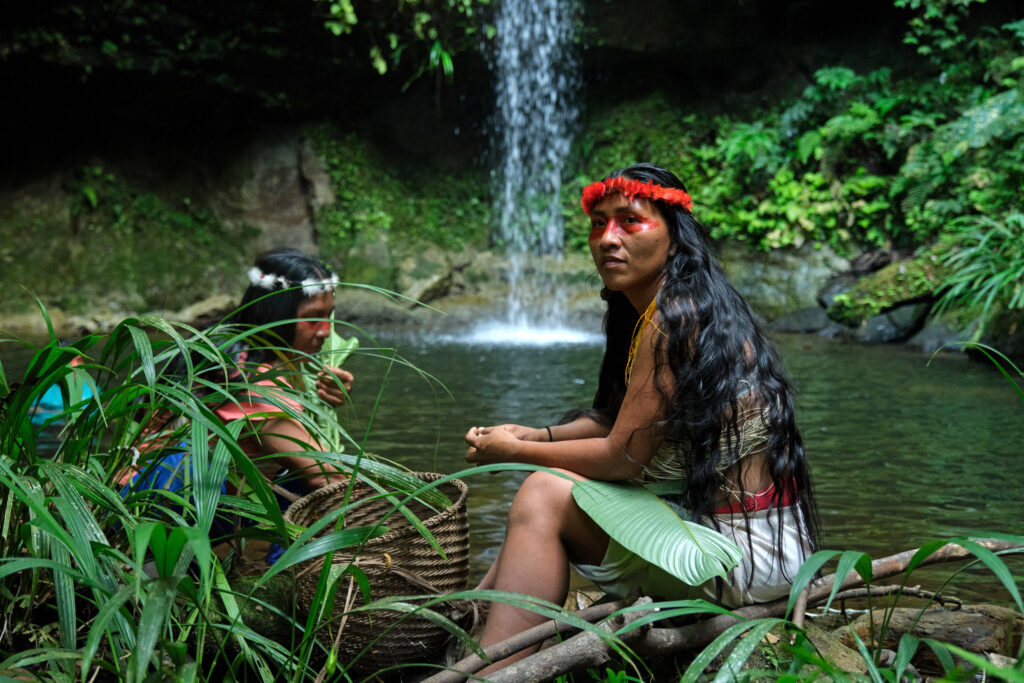Members of the Indigenous Waorani village of Kiwaro looked skyward as a helicopter hovered over the rainforest canopy in the center of Ecuador and landed in a nearby clearing. Out stepped government officials, there to inform the community about an impending auction of oil rights on their land.
The Ecuadorian government announced earlier, in November 2011 from the capital city Quito, that it would open up for drilling millions of hectares of Amazon rainforest—including the ancestral territories of Waorani communities like Kiwaro.
According to court documents, the officials’ time in the village was brief. There was no detailed explanation of what oil extraction entailed. No discussion about oil operations’ negative impacts. The community’s official leaders, known as pikenani, weren’t present at some meetings. And officials spoke in Spanish, not the community’s Waotetero language. Across the region slated for drilling, dozens of other consultation processes followed similar patterns—if they happened at all. Later analyses showed that the government only spoke with about 7 percent of people affected by the planned operations.
Neither the Ecuadorian Consulate in Washington, D.C., nor representatives from the Ecuadorian Ministries of Environment or Energy and Mines responded to requests for comment. But officials have previously said they complied with government regulations and acted in good faith.
With extractive industry pressures intensifying worldwide, Indigenous groups, governments and businesses have been pushing courts to clarify ambiguities in the laws.
Today, it’s not just oil companies knocking at communities’ doors. Mining—legal and illegal—has exploded in the Ecuadorian Amazon and beyond. Indigenous lands hold more than half of the world’s minerals used in low carbon and modern-day technologies like computers and cell phones. Those lands also are home to more than a third of the world’s remaining intact forests, and conservation efforts have emerged as another threat. Some carbon schemes and national parks have had links to forced displacements and other human rights violations.
In theory, FPIC acts as a safeguard against these and other abuses. But in practice, Indigenous leaders and outside experts say governments frequently carry out performative meetings, with rushed or bare-bones presentations made to select representatives.
“There is a tendency of governments to want a tick box,” said Cathal Doyle, legal and human rights program coordinator at the U.K.-based nonprofit Forest Peoples Programme.
Governments’ emphasis on speed and efficiency can undermine the purpose of FPIC, experts like Doyle say.
Consultations must be adapted to each community’s distinct customs, many of which rely on consensus-based decision-making processes that can take months or more than a year, said S. James Anaya, a former United Nations special rapporteur on Indigenous peoples’ rights.
Doyle’s work allows him to see how often the right to free, prior and informed consultation is fully complied with. “It’s rare,” he said.
There are, he added, some instances where communities’ decisions to withhold consent for actions or projects have been respected, but those have often been at the end of a long struggle with a huge amount of advocacy and mobilization.
To assume hundreds of millions of people think alike or live under the same circumstances is a mistake, Indigenous leaders and researchers say. So too is the presumption that all Indigenous communities use the FPIC process to oppose extractive industries.
Some communities have used consultations to negotiate economic benefits, jobs, land protections and environmental safeguards, said Anaya, who also served as dean of the University of Colorado Boulder Law School.
“In much of the world, it’s assumed that Indigenous peoples are never interested in development—and that’s a myth,” Anaya said. What matters, he added, is that Indigenous peoples have a choice, and that agreements with governments or private companies are made on “just and equitable terms.”
It should always be the indigenous people. Land back, all of it.



